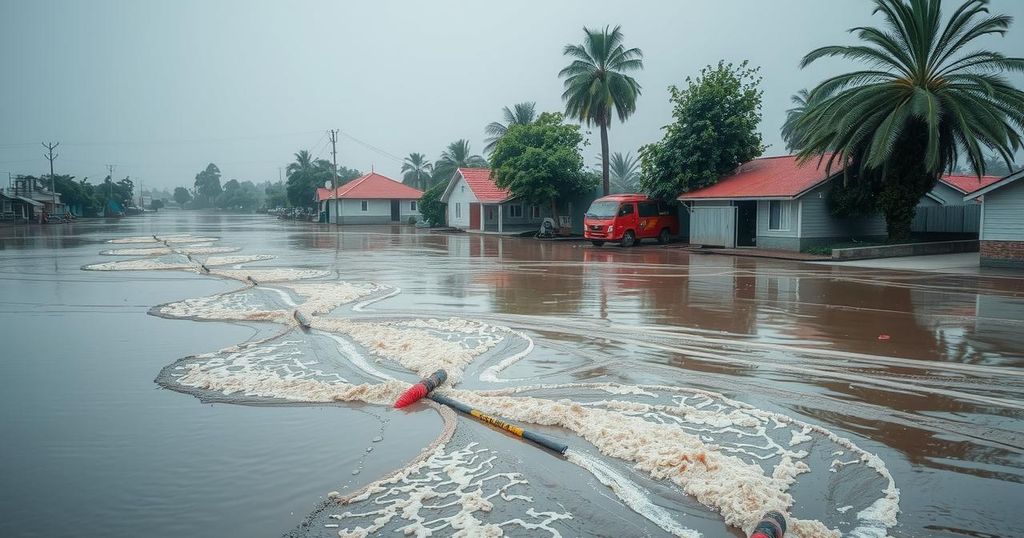The recent overflow of the Nile River has displaced over 379,000 people in South Sudan, leading to significant challenges, including food scarcity, lack of infrastructure, and health care access. Villages have been submerged, and residents like Bichiok Hoth Chuiny must rely on makeshift communities for survival. The escalating flooding crisis exacerbates existing vulnerabilities due to climate change and prolonged socio-political conflicts, highlighting the urgent need for humanitarian aid and resilience-building efforts.
The overflowing Nile River has led to widespread flooding in South Sudan, displacing thousands of individuals and families. The village of Gorwai, along with many others, has been submerged, leaving residents like Bichiok Hoth Chuiny struggling for survival in makeshift communities. In Pajiek, the newly established refuge sees long-horned cattle wading in water, while families build homes from mud and grass after losing everything to flooding. This disaster exacerbates the struggles of pastoral communities in Jonglei state, already vulnerable due to climate change and political instability.
The annual flooding, which has intensified over the years, has forced more than 379,000 people from their homes in 2023 alone, as reported by the U.N. humanitarian agency. Seasonal floods have traditionally impacted agricultural lifestyles, but since the 1960s, the situation has deteriorated due to climate change and increasing water levels. According to Daniel Akech Thiong from the International Crisis Group, the Dinka, Nuer, and Murle communities are losing their traditional means of sustaining livestock and crops.
With floods attributed to the release of water from upstream dams in Uganda, the once-promising Jonglei Canal, initially designed to manage Nile waters, has become a refuge for displaced individuals. Although some inhabitants of Pajiek attempt to cultivate small gardens, the lack of infrastructure creates significant hardships; there are no schools or clinics, and aid is critically needed. The area lacks basic facilities, making survival challenging for its residents, who frequently rely on food aid from the World Food Program, while ongoing conflicts complicate the situation further.
Additionally, the health services are in dire straits. Many villagers suffer from neglect, while essential medical supplies and personnel availability are drastically low. One clinical officer reported the struggle to provide care when patients present alarming health issues, such as snake bites, but lack of resources hampers their ability to cope.
The impact of this continuous flooding scenario paints a dire picture for South Sudan, whose challenges include conflict, economic hardship, and climatic disasters that threaten the very fabric of its agricultural communities.
The current flooding crisis in South Sudan arises from a multifaceted interplay of climatic and socio-political factors. The region is known for its vulnerable geographic and climatic conditions which have been exacerbated by climate change, resulting in recurring and severe flooding incidents. Historically, pastoral communities have adapted to seasonal floods; however, alarming trends of increasing water levels have contributed to the submerging of villages and displacement of people. The and political instability, characterized by ongoing conflict since the nation’s independence in 2011, further complicates the scenario, leaving affected individuals with little to no means for recovery and resilience. With the World Bank designating South Sudan as the most vulnerable country to climate change, understanding the implications of these flood disasters necessitates an appreciation for both environmental and social dynamics at play.
In summary, the overflowing River Nile and resultant floods in South Sudan have caused extensive displacement and loss of livelihood, particularly among pastoral communities. The inundation of historical villages and the establishment of refugee settlements reveal the dire consequences of climate change, unmet infrastructural needs, and political instability. Access to basic services and food assistance remains critical for the survival of displaced families. As floods continue to devastate the lives of many, the international community’s response and support become increasingly essential to alleviating the suffering endured by these vulnerable populations.
Original Source: www.independent.co.uk






